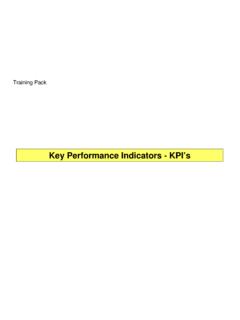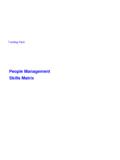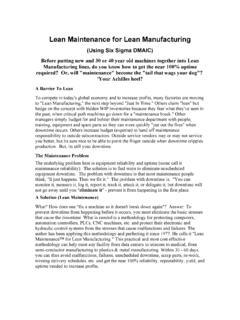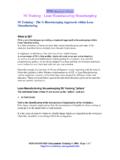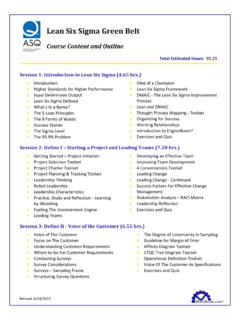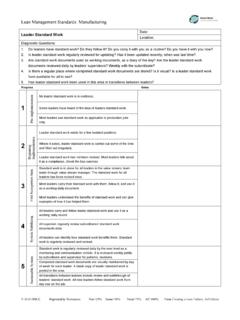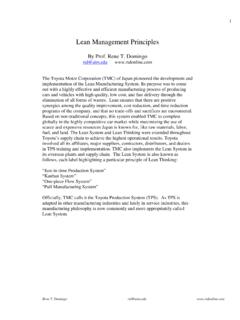Transcription of Autonomous Maintenance - Lean Six Sigma
1 Autonomous MaintenanceTraining PackAims & ObjectivesTarget Audience: Autonomous Maintenance Champions, Production of Module:To equip attendees with the knowledge & understanding to participate in Autonomous Maintenance Activities, in order to deliver tangible and sustainable improvements in equipment reliabilityAims & Objectives : Outline the Steps of AM Give Practical Guidance on AM roll outWhat is Autonomous Maintenance ? An operator Skill development Programme An approach to allow problems to be identified and solved quickly An approach to stop accelerated deterioration of plant and equipment An approach to stop deterioration related failures An approach to stabilise equipment conditions (standards) An approach to develop training materials on how to run, operate & maintain equipmentWhat is Effective Maintenance ?
2 An Effective Maintenance system will support Autonomous Maintenance . Effective Maintenance should also involve all areas of the organisation. Information is key. Operator and Maintainer training Up-skill Maintenance to be trainers and equipment improvers Up-skill Operators to be equipment maintainers ( Autonomous Maintenance )PACDC heckActPlanDoHow do we Implement Autonomous Maintenance ?IMPROVE HUMAN RESOURCESIMPROVE PLANT AND EQUIPMENTIMPROVE CORPORATE CULTUREStep 2 - Eliminate Contamination & Inaccessible areasStep 4 - Finalise Standards & TrainStep 0 - Education - Machine FunctionStep 1 - Initial Clean & Inspect Step 3 - Develop Provisional StandardsHow do we Implement Autonomous Maintenance ?Evidence of successDevelop confidencein their abilitiesTeams practiceautonomous kaizenEffectReduceddefects &failuresTeam memberschangeChange in cultureMove fromreactive toproactiveChange in activitiesPositive participationKaizen thoroughnessof Maintenance & controlworkingenvironmentchangesChangeeq uipment condition* Understanding the machine functions Cleaning is inspection* Inspection can detect abnormalities* Abnormalities can be rectifiedImprove skillsTIMEZero defects &failures arerealisedEffectHow does Autonomous Maintenance Work?
3 Step 0 Step 1 Step 2 Step 3 Step 4 Step 4 The way that the stages of Autonomous Maintenance are described as steps, promotes how Autonomous Maintenance works. To get from the bottom to the top it is easier to use evenly spaced comfortably sized steps. You must maintain each step as you progress, or the whole thing will crumbleHow does Autonomous Maintenance Work?Step 0 - Education - Machine FunctionThe 5 Steps of Autonomous MaintenanceStep 0 is about increasing our basic understanding of machine components and function. To help us with this we utilise the knowledge of engineers, and use machine components sheets to store this information. Step 0 - Education - Machine Function Machine Component Sheets help us to understand how equipment works, and what can cause it to fail They also make a very effective training aidMachine Components - Product PumpsComponentsFunctionPossible causeof failureEg.
4 Machine Components SheetStep 0 - Education - Machine FunctionMachine Components - Product PumpsComponentsFunctionPossible causeof failureHow Does It Work?How Can it Fail?Step 0 - Education - Machine Components SheetsMachine Components - Product PumpsComponentsFunctionPossible causeof failureTIPS Should Initially be Hand drawn Should be completed at the machine in question Should be led by an experienced engineerStep 0 - Education - Machine Components Sheets Tool to Communicate Improvements Tool to capture ideas Tool to share knowledge Tool for effective training Three types of OPL Basic Knowledge Improvement Idea Downtime Problemcr ewsCRAFTT/LT/MT/M1234 LINEAREA/MACHINENoTHEMEPREPARED BYDATEBA S ICKNOWLEDGEIMPROVEMENTCA S ESTR OUB LECA S ESO NE PO IN T LE S S ONGauge needs to read between red markers within green zone.
5 Step 0 - Education - One Point Lessons (OPL s)TIPS Should Initially be Hand drawn Should be 80% Drawing 10% Words Should only take 5 mins to teach Adopt a company numbering system Should be verified by an engineer Use the bottom of the sheet as a training recordcr ewsCRAFTT/LT/MT/M1234 LINEAREA/MACHINENoTHEMEPREPARED BYDATEBA S ICKNOWLEDGEIMPROVEMENTCA S ESTR OUB LECA S ESO NE PO IN T LE S S ONGauge needs to read between red markers within green zone. Step 0 - Education - One Point Lessons (OPL s)Guidelines Keep it Simple Use Own Staff Humour Maximum 20 mins Plan the video Communicate intention to all staffStep 0 - Education - Instructional VideosTrainedA N OtherJ BloggsTeam 1 Process AM Skills Training MatrixUnder Pinning KnowledgeGuidelines Based on detailed checklists that include Skills and Knowledge Required to complete Tasks Notes on how to carry out assessments Based on standard work instructionsStep 0 - Education - Skills AuditStep 0 - Education - Machine FunctionStep 1 - Initial Clean & InspectThe 5 Steps of Autonomous MaintenanceProblem DetectionRestorationSet StandardsMachine AwarenessCleaning IS Inspection!
6 Step 1 - Initial Clean and InspectMachine concern / fault analysis ..through cleaning you touch, through touching you findwhen you find, you fix !!20 of 42 Step 1 - Initial Clean and InspectMachine:M/c 1265 Date: 15/08 Completed by: J Brown NoLocation / FaultCodeclassCauseTempPermCountermeasur eWhoWhen1 Pressure Gauge notwithin limitH3 Poor labellingTPEnsure manual setting onlabelWrite Setting on SettingsheetTeamTeam1/111/112 Measuring probeunprotected next topalletE9 Poor designTPCover to be madeReview machinespecificationNCMTMRWk 26Wk 263 Oil Leak next totwin palletL4 Poorly installedTPFix leakReview installationprocedureMaintMRWk 25Wk 27 CodeEElectricalMMechanicalLLubricationHH ydraulicPPneumaticWWaterClass1 Loose2 Worn3 Broken4 Leaking5 Missing6 Dirty7 Difficult to clean8 Location / Routing9 Poor designClean & Inspection Fault Finding SheetMachine:Completed by.
7 NoLocation / FaultCodeclassCauseTempPermCountermeasur eWho WhenCodeEElectricalMMechanicalLLubricati onHHydraulicPPneumaticWWaterClass 1 Loose2 Worn3 Broken4 Leaking5 Missing6 Dirty7 Difficult to clean8 Location / Routing9 Poor designDateClean & Inspection Fault Finding SheetEMLHWPTOTAL123456789 TOTALCODE CLASSE = ELECTRICALM = MECHANICALL = LUBRICATIONH = HYDRAULICW = WATERP = PNEUMATIC1 = LOOSE2 = WORN3 = BROKEN4 = LEAKING5 = MISSING6 = DIRTY7 = DIFFICULT TO CLEAN8 = LOCATION & / OR ROUTING9 = POOR DESIGNCONCERN / FAULT ANALYSISC lean & Inspection Concern/Fault Analysis Sheet Makes defects easier to detect. Better customer perception. Creates a better working environment. Aids efficiency and reduces accidents.
8 Helps 2 - Eliminate Contamination & Inaccessible areasStep 0 - Education - Machine FunctionStep 1 - Initial Clean & InspectThe 5 Steps to Autonomous MaintenanceMaintain Cleaning StandardsReduces Inspection TimeMakes Maintenance EasierQuick CorrectionStep 2 - Eliminate Contamination and Inaccessible AreasMACHINE MAPPING Group exercise. Lead by an experienced engineer/maintainer. Use in conjunction with Tags .Tag 1 Tag 2 Tag 3 Tag 4 Tag 5 Tag 6 Tag 7 Tag 8 Tag 9 INITIAL EQUIPMENT SURVEYP lanned Maintenance - Initial Equipment SurveyTag 1 Tag 2 Tag 3 Tag 4 Tag 5 Tag 6 Tag 7 Tag 8 Tag 9 TIPS Group Exercise Identify Sources of contamination Identify inaccessible areas Should be led by an experienced engineer Can be used in conjunction with a red tag exerciseStep 2 - Eliminate Contamination - Machine MappingTIPS Aim to reduce cleaning time Aim to reduce inspection time Make essential equipment access easier Simplify equipment operationsStep 2 - Eliminate Inaccessible Areas - Machine MappingStep 2 - Eliminate Contamination & Inaccessible areasStep 0 - Education - Machine FunctionStep 1 - Initial Clean &
9 InspectStep 3 - Develop Provisional StandardsThe 5 Steps to Autonomous MaintenanceCleaning StandardsLubrication StandardsInspection StandardsSchedulesStep 3 - Develop Provisional StandardsDate:Machine:Cleaning ItemsLubrication & Inspection ItemsDItemCItem to CleanProcess:LatheJIG REMOVALLOCATING PINTLEAREA AROUND SHAFT123 SUPPORTING ACTUATOR SHAFT4 LOCATING PINTLE - INSPECT FORWEAR, LUBE WHERE NECESSARY1C3 + D2C1 + D1 REPORT ANY DAMAGE TO TEAM LEADERSUPPORTING ACTUATOR SHAFT -2 GENERAL AREAAS ABOVE3 Step 3 - Develop Provisional Standards -Cleaning, Lubrication and InspectionPolicyGoalsTargetsMachine Component SheetsEfficiency ChartGraph Of Problem AreasBox ofRed TagsRadar ChartRed TagRecordSheetAudit Checklist30 ProblemListBefore /AfterPhotosBefore /AfterPhotosCountermeasuresHard To Access AreasImprovement OPL sOPL sThe TPM BoardTIPS Display all work from steps 1 - 3 Locate the board in the work area Present the board & improvements to senior managers Ensure that the board is up to date and owned Establish a standard that other boards can adoptThe TPM BoardStep 2 - Eliminate Contamination & Inaccessible areasStep 4 - Finalise Standards & TrainStep 0 - Education - Machine FunctionStep 1 - Initial Clean & InspectStep 3 - Develop Provisional
10 StandardsThe 5 Steps to Autonomous MaintenanceManagement Buy OffStructured TrainingEffective Knowledge ManagementStandard PracticeStep 4 - Finalise Standards and TrainAll the operatorsAll the All the operatorsoperatorsTrainersTrainersTraine rsGroup leadersGroup Group leadersleadersAMAMAMStep 4 - Finalise Standards and Train -DeploymentTraining Should Include:- Parts names, structure and function of equipment Problems and their corrective actions Keypoints, methods, and criteria for inspection Inspection practice38 of 42 Step 4 - Finalise Standards and Train - Training ContentsMachine Components - Product PumpsComponentsFunctionPossible causeof failureSec tion Na meAutonomous Maintenancestandards (Inspection)Sec tion Num berKC reat ed on05 /04/0 0 Page NumberStanda rd Operatin g Proc edure sTask:Insp ect bat h pe gs for any d ama ge a ndcheck th at th e spr in gs are in po sition.





